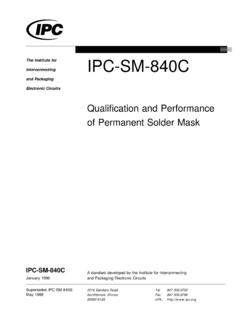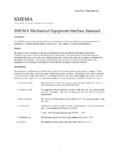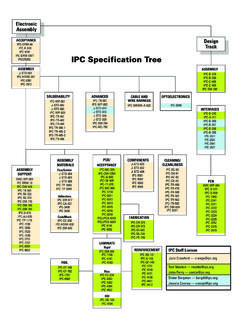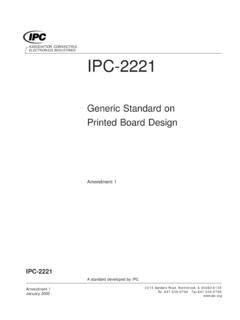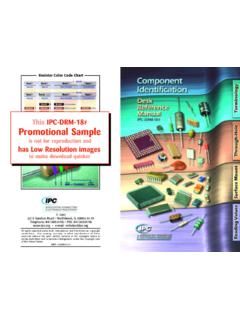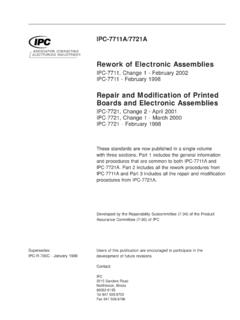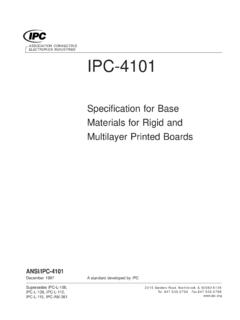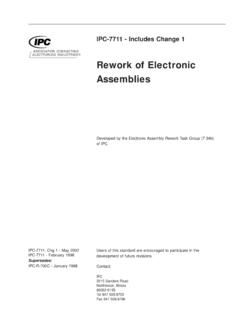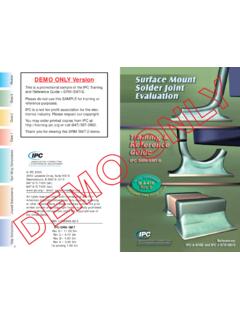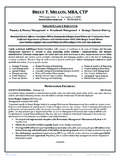Transcription of ANSI/J–STD-003 JOINT INDUSTRY STANDARD
1 JOINTINDUSTRYSTANDARDS olderability TestsforPrinted Boards1st WORKING DRAFTANSI/J STD-003 APRIL 1992 INDUSTRESEST. 1924 CINORTCELIEAASSOCITIONAMERICAN NATIONAL STANDARDT able of Scope .. Purpose .. Performance Classes .. Method Tests with Established Test(s) without Established Accept/Reject Test Method Test Specimen Coating Limitation .. APPLICABLE Terms and Flux Removal Material .. Steam Aging Solder Pot/Bath .. Optical Inspection Dipping Timing Preparation for Specimen Preparation and ConditioningFor Steam Solder Bath Requirements .. Solder Solder Contamination TEST Test Procedure Limitations .. Application of Tests with Established Accept/Reject Criterion .. Test A Edge Dip Test B Rotary Dip Test.
2 Test C Solder Float Test D Wave Solder Test(s) without Established Accept/Reject Criterion .. Test E Wetting Balance Test .. EVALUATION Evaluation Aids Evaluation Aids For Class 3 Test Equipment Edge Dip Solderability Test Apparatus .. Rotary Dip Test Wetting Balance Test Steam Aging Wetting Times .. Correction for Baking/Testing Time Delay .. Safety Use of Non-Activated Other Solder Steam 16 FiguresFigure 1 Contact angle .. 3 Figure 2 Edge dip solderability 6 Figure 3a Suggested test specimen for 7 Figure 3b Suggested test specimen for surface 8 Figure 4 Rotary dip 8 Figure 5 Effectiveness of solder wetting of plated-through holes Class 3 .. 9 Figure 6 Wetting balance apparatus .. 12 Figure 7a Wetting time acceptance 13 Figure 7b Wetting force acceptance 13 Figure 8 Wetting balance 14 Figure 9 Aid to 15 TablesTable 1 Test Method 2 Table 2 Accelerated Aging and Test 2 Table 3 Maximum Limits of Solder Bath Contaminant.
3 3 Table 4 Steam Temperature Requirements .. 4 April 1992 IPC-STD-003ivSolderability Tests for Printed ScopeThis STANDARD prescribes the recommendedtest methods, defect definitions and illustrations for assess-ing the solderability of printed board surface conductors,attachment lands, and plated through-holes. This standardis intended for use by both vendor and PurposeThe solderability determination is made toverify that the printed board fabrication processes and sub-sequent storage have had no adverse effect on the solder-ability of those portions of the printed wiring boardintended to be soldered. This is determined by evaluationof the solderability specimen portion of a board or repre-sentative coupon which has been processed as part of thepanel of boards and subsequently removed for testing perthe method ObjectiveThe objective of the solderability testmethods described in this STANDARD is to determine the abil-ity of printed board surface conductors, attachment lands,and plated through-holes to wet easily with solder and towithstand the rigors of the printed board assembly Performance ClassesThree general classes havebeen established to reflect progressive increases in sophis-tication, functional performance requirements and testing/inspection frequency.
4 It should be recognized that theremay be an overlap of equipment categories in differentclasses. The user has the responsibility to specify in thecontract or purchase order the performance class requiredfor each product and shall indicate any exceptions to spe-cific parameters, where 1 General Electronic ProductsIncludes consumer products, some computer and computerperipherals, as well as general military hardware suitablefor applications where cosmetic imperfections are notimportant and the major requirement is function of thecompleted printed 2 Dedicated Service Electronic ProductsIncludes communications equipment, sophisticated busi-ness machines, instruments and military equipment wherehigh performance and extended life is required and forwhich uninterrupted service is desired but not critical. Cer-tain cosmetic imperfections are 3 High Reliability Electronic ProductsIncludes the equipment for commercial and military prod-ucts where continued performance or performance ondemand is critical.
5 Equipment downtime cannot be toler-ated and must function when required such as in life sup-port items or missile systems. Printed boards in this classare suitable for applications where high levels of assuranceare required and service is Method ClassificationThis STANDARD describes testmethods by which both the surface conductors (and attach-ment lands) and plated through-holes may be evaluated are made for this determination to be performedat the time of manufacture, at the receipt of the boards bythe user, or just prior to assembly and soldering. User andvendor shall agree to the appropriate method to be usedand their dwell times are defined in some of the methodscalled out in this STANDARD . Variations in board heat capac-ity may necessitate the use of longer solder dwell times(see paragraph ). Any change in solder dwell shall beagreed upon by user and Tests with Established Accept/Reject CriterionTest A Edge Dip Test (For surface conductors andattachment lands only)Test B Rotary Dip Test (For plated through-holes, sur-face conductors and attachment lands, soldersource side)Test C Solder Float Test (For plated through-holes, sur-face conductors and attachment lands, soldersource side)Test D Wave Solder Test (For plated through-holes, sur-face conductors and attachment lands, soldersource side) Test(s) without Established Accept/RejectCriterionTest E Wetting Balance Test (For surface conductors andattachment lands only)Please forward all test data generated using this testmethod, including type of board tested (such as Type 2 or12 layer, Type 3), dimensions of coupon tested, and anypretreatment, to.
6 IPCW etting Balance Task Group (PWB)2215 Sanders RoadNorthbrook, IL Test Method SelectionFor appropriate test selectionrefer to paragraph and Tables1& selectionApril 1992J-STD-0031

